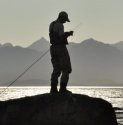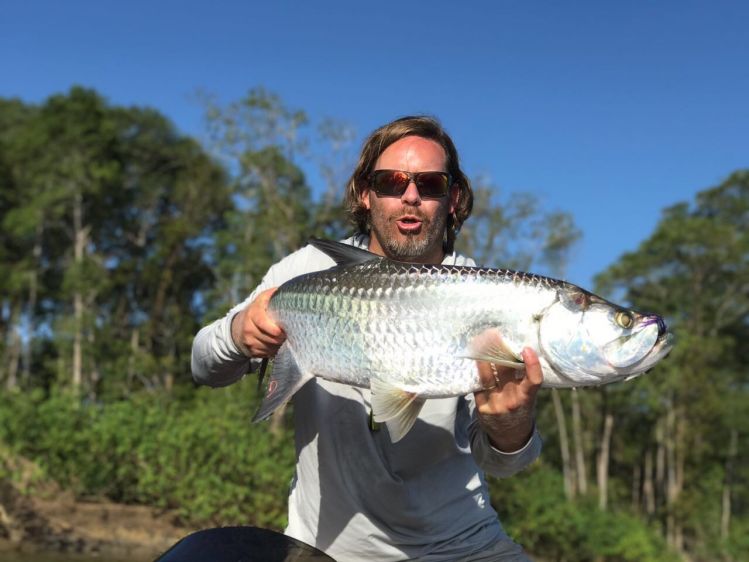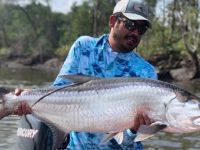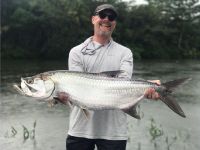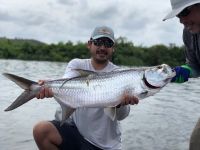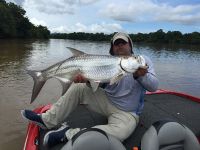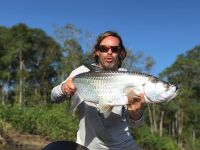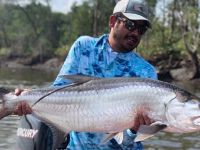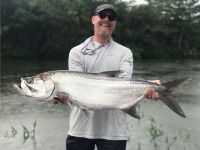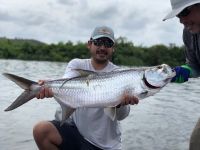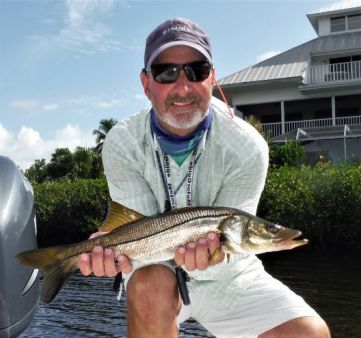Fd: Can you tell us a bit about how the idea of setting up a fly-fishing operation in Panama came up?
We had been exploring Patagonia for decades. Over the course of the years we have found many amazing places and caught thousands of Patagonian trophy size fish on flies in all shapes and methods. We always had in mind to set up an operation in Chile just for the pure passion of it all.
Having been to many fly fishing lodges and operations we always envisioned our “perfect fly fishing/lodging scenario” and that needed to fulfill three main characteristics:
All about fishing: Not horse back riding, Not bird watching, Not camping, etc. There has to be great (not good, but great) fish density/sizes, a ton of them and wild.
The lodging has to be great as well. You need to rest and eat well. This is one of the main problems we’ve seen in so many fishing lodges in Patagonia. They are so remote that fixing things doesn’t come easy. It means that, most of the time, some of the important things don’t work entirely well, like the shower, or the toilet, the water supply, heaters, etc.
It is a dream when the great fishing occurs relatively near home. Most of us globetrotting anglers travel very far to go fishing in prime spots, resulting in 3, 4 or even 5 flights before even getting to the car or boat that is going to transport us, for some hours, to the place.
When we explored Panamá for the first time we were lucky enough to follow our instincts. We did exactly the opposite of what other fishermen were telling us to do in order to catch fish in the country and, with a lot of driven stubbornness, researched just the right place. We were able to find the three key factors we would have wanted for any fishing operation. It was not easy, it took us almost two years to really understand how to fish it and how to operate it. But from day one we knew we had found something very special.
Fd: Why do you think every fly fisherman should visit your destination?
We do not think our destination is for every fly fisherman.
We would love for it to be for every fisherman, but what we are offering is an experience you’ll never forget in your life. So, we really think to enjoy this experience one at least needs to have some experience fishing with big rods (at least 8 wt). Also, accuracy is important because even if the river is full of tarpon, the cast in the right place is going to increase your chances of hooking a tarpon… So we want to be very honest with our customers about that before they book a trip with us.
Fd: How are the tarpon migrations in these areas?
Tarpon live and feed in the river during the whole year! As there are no scientific studies to determine the movements of fish we can hypothesize from our observations that Tarpon over 120 lbs appear in the river when certain bigger baitfish schools migrate upstream, but we have seen them quite often in different months of the year, not necessarily following a seasonal pattern.
Fish between 10 lb. and 120 lb. are sitting in defined spots along the river, feeding throughout the year.
Fd: During which months is the tarpon season open over there?
It’s always open.
One can observe two different “seasons”, the rainy months from April through November and the dry months from December to March. Tarpon live and feed in the river in both “seasons”.
In general, higher numbers are caught during the rainy months because they spend more time in the surface, but we have done extremely well during the dry season too. Fishing tactics change though, as water level, sun exposure, and tide velocity change as well.
Fd: What kind of fly-fishing gear should anglers take for a week over there?
We expect that every angler can travel light, free of fishing gear. We have everything needed for them unless they would like to try a specific rod brand, or a cool reel they got for Christmas.
We use two sizes of one handed rods: 10 wt for most of the fishing and 12 wt when we hit spots with fish over 50lb. Because tarpon live in the river and feed in defined spots and runs, very much like a big brown trout does, we need to be constantly casting towards the banks, which we have found is physically possible for most anglers with a 10wt rod. Still, a 10 wt rod on a typical 30 - 40 lb river Tarpon feels like a child´s toy rod. But in the conditions we fish in, a 10 wt is clearly the most energy/precision effective tool for the angler (it is funny to talk about precision with a 10 wt stiff rod, but all things are relative when fishing for tarpon).
Although this is not technically saltwater fishing, we use the best possible saltwater reels that can handle abuse and powerful enough disc drags to be able to stop a jumping torpedo that is trying to go under a sunken tree.
For lines, we use all kinds of lines from floating to ultra fast sinking lines. The line type will be the one factor to adapt for each specific light, rain, tide and water level condition.
Fd: What are the top flies that should be included in our boxes?
EP Tarpon Streamer in size 4/0. Purple and black, black death tarpon, peanut bunker. That’s it!
Fd: How's the program for a typical fly-fishing day?
We would love to maintain the following plan:
Wake up at 4:30 am, get dressed, have a nice coffee, hop in the car at 5:00 am, have a delicious breakfast while getting to the river, hop in the boats at 6:00 am, be hooking the first tarpon at 6:15 am.
A quick snack is served at 9 am, continuing to hit every spot.
Lunch is served in the boat below a huge jungle tree, at 12:00 pm. We take a nap until 14:00 on the boat, keep fishing, have a rest/eat break at 16:00 hrs, wrap up the day at 18:00 hrs.
Hop in the car, get back to the hotel at 19:30, take a nice warm shower and hit the dining room at 20:00. Have a great meal and conversation and be sleeping like baby at 21:30 hrs.
But, that is just a written plan on a piece of paper. In reality, our guest is the queen or king and decides, each day, what would be her or his plan as the day unfolds. We will not say “ok, its over, we need to have lunch know” if 10 tarpon are rolling right in front of us. Our experience is that fishing drives the angler and it will dictate his planning during the first two days, and then onwards he/she will want to lay back a bit and rest a little more.
Fd: How is the lodging in terms of accommodation and facilities?
The best we have ever experienced in a fishing operation. Because the river is so close to Panama City, we have decided to partner up with two of the best five star hotels in the City. Another great bonus of being in Panama City is that many (around 40%) of our guests come with their non fishing partners, so they are able to enjoy not only the hotel amenities but also what Panama City surroundings have to offer.
Fd: How long before should anglers contact the lodge for reservations?
We recommend a minimum of 2 months in advance. Also, ticket prices for airlines are always cheaper when booked at least a couple of months in advance. This gives the guest more options regarding arrival and departure time.
Fd: Any other advice for those visiting your area?
Bring the right clothes: lightweight, light colored, long sleeves for the arms, and legs as well, to avoid sunburn, lightweight gloves, a hat with neck cover or a good hoody lightweight shirt. And very important from April to November, always bring waterproof vest and pants. A pair of good sunglasses, and wipes because you might need to clean them very often.
Mosquito repellent is optional because we don’t have mosquitoes in the river where we fish.
Find more info and contact the guides directly through the Travel directory, here: Travel

